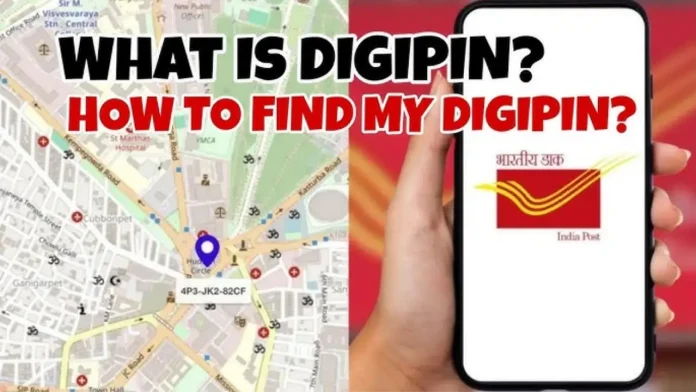India Post, with IIT-Hyderabad and ISRO-NRSC, has launched Digipin—a 10-character, alphanumeric and open-source digital address code covering every approx 4m × 4m grid across India.
Think of it as the ultimate location zoom—not just a neighbourhood (like PIN), but your exact doorstep, whether in a remote village, apartment, or even in the ocean!
You can get your Digipin via the “Know Your Digipin” portal or app—either auto‑generated with GPS or keyed in manually with coordinates.
It coexists with PIN codes, enhancing them—not replacing them—offering precise delivery, emergency response, digital gov services, and logistics improvements.
Privacy is built-in: Digipins are pure geocodes—no personal data stored, and you share them only intentionally
It works offline and is open-source, with code and APIs available to developers—built for integration in apps, maps, logistics systems even in remote areas .
How Digipin Works: The Science of Grid Power
Here’s the breakdown:
- India is divided into an invisible grid—each square about 4 × 4 metres (think the size of a large room or SUV).
- Each grid gets assigned a unique 10-character alphanumeric code derived from its latitude-longitude coordinates.
- Use a GPS-enabled phone or map: the system tells you your Digipin instantly. Or enter coordinates manually if needed.
- It works offline, no data stored—ideal for remote areas with poor connectivity. Source code is public, so it’s developer-friendly.
Bottom line: Digipin gives you map-level accuracy—even where formal addresses fail.
Digipin vs PIN Code: What’s the Real Difference?
| Feature | PIN Code | Digipin |
|---|---|---|
| Area Covered | Several neighbourhoods (10,000 m²+) | ~4 × 4 m² square |
| Format | 6-digit numeric | 10-character alphanumeric |
| Precision | Approximate | Exact geolocation |
| Use Case | Postal delivery | Deliveries, emergency services, digital IDs |
| Digital/Nomadic | Static, area-based | Dynamic, place-specific |
| Privacy | NA | Privacy-first, no personal data stored |
In essence, your PIN says “Welcome to Newtown”, but Digipin says “Welcome to flat 302B balcony”.
How to Get Your Digipin: Step-by-Step
On Your Smartphone or Desktop:
- Visit the Know Your Digipin portal on India Post’s website.
- Allow GPS or enter your latitude-longitude manually.
- The 10-character Digipin appears on screen—copy it, share it, or bookmark.
For PIN code accuracy:
- Use the Know Your PIN Code portal.
- Allow GNSS use or place your location on the map.
- Get precise 6-digit PIN code based on your location—and submit feedback to refine results.
Why Digipin Matters: Real-World Benefits
1. Last-Mile Delivery
No more confusion among streets with similar names—couriers and e-commerce giants can pinpoint exactly, reducing delays and errors.
2. Emergency Response
Ambulances, firefighters, and disaster teams can zero in precisely—saving crucial minutes in rural, slum, forest, or flood-hit areas.
3. Digital Governance
Works with AaaS (Address-as-a-Service) for public schemes—land records, social welfare, taxation—without messy paperwork.
4. Developer & Business Tools
Open-source APIs encourage innovation—parking apps, mapping startups, microfinance—all get accurate locational ties.
5. Infrastructure Planning
Urban planners and service providers now get granular footprint—each home, each plot, precisely mapped.
Privacy & Security: Why You Shouldn’t Worry
- Only location coordinates go into generating Digipin—no names, no pics, no personal data
- Offline functionality means your location stays on your device—no cloud uploading.
- Shared only when you choose (e.g., typing your Digipin in an app)—not publicly broadcast.
It’s like a global plus-code—but born and built in India.
Coexisting with PIN Codes: Will PINs Disappear?
Nope! Both systems will coexist:
- PIN codes for broader area-based identification—postal zones, neighbourhoods.
- Digipin for hyperlocal precision—agile tool for real-time delivery, emergencies, cloud-based forms, remote geocoding
Think of PIN as your “town party zone” code, and Digipin as your “party room access.”
“Without Digipin, my address was ‘House number, near that old banyan tree, next to Raju’s shop.’ Now I just say: here’s my 10‑character ID!”
FAQs:
Q1: Is Digipin just like Google Plus Codes or What3Words?
A1: Similar concept—grid-based geocodes—but open-source, India-specific, Indo-friendly, and integrated by India Post with national reach .
Q2: Do I need an app or internet?
A2: No app needed. Just open the “Know Your Digipin” portal in any browser (even mobile) and use GPS or manual coords. Works offline after code generation.
Q3: Will agencies enforce Digipin use?
A3: Likely—government, delivery, even e-commerce may ask for Digipin in forms or apps, especially where it’s hard to give proper address.
Q4: What about rural/far-off areas?
A4: That’s the sweet spot. In villages, forests, islands—where traditional addresses fail—Digipin is a game changer.
Q5: Will it work on boats or airplanes?
A5: Yes—grids cover maritime zones too, so if your floating Airbnb has GPS, it gets a code.

Digipin is more than a code—it’s a national leap into precision, inclusivity, and digital-first governance. It solves real-world problems: unclear addresses, delivery failures, emergency delays, red tape, and even digital fraud.
It’s open, free, offline-ready, and privacy-safe—a foundation stone for Digital India 2.0.


